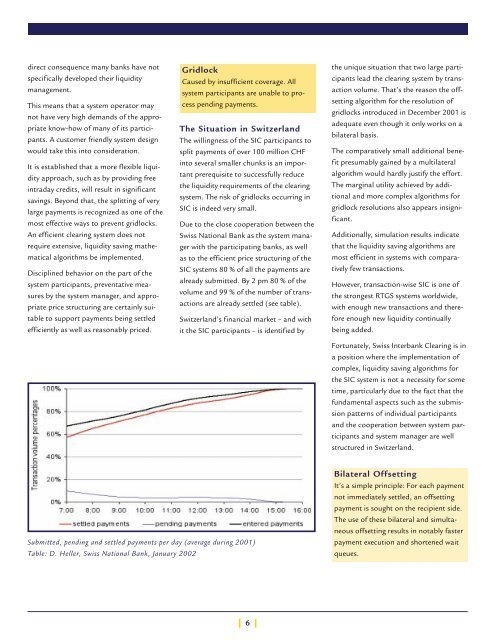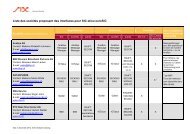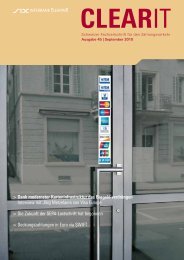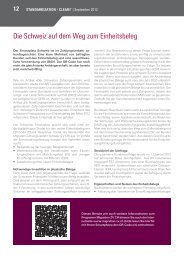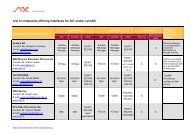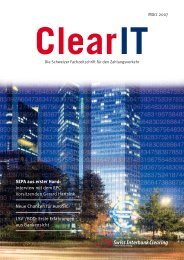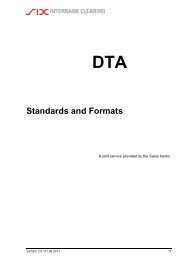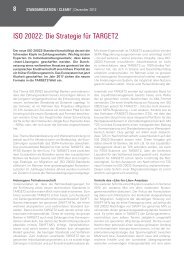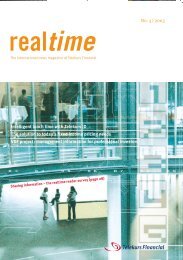No. 14 – Aug 2002 - SIX Interbank Clearing
No. 14 – Aug 2002 - SIX Interbank Clearing
No. 14 – Aug 2002 - SIX Interbank Clearing
Create successful ePaper yourself
Turn your PDF publications into a flip-book with our unique Google optimized e-Paper software.
direct consequence many banks have not<br />
specifically developed their liquidity<br />
management.<br />
This means that a system operator may<br />
not have very high demands of the appropriate<br />
know-how of many of its participants.<br />
A customer friendly system design<br />
would take this into consideration.<br />
It is established that a more flexible liquidity<br />
approach, such as by providing free<br />
intraday credits, will result in significant<br />
savings. Beyond that, the splitting of very<br />
large payments is recognized as one of the<br />
most effective ways to prevent gridlocks.<br />
An efficient clearing system does not<br />
require extensive, liquidity saving mathematical<br />
algorithms be implemented.<br />
Disciplined behavior on the part of the<br />
system participants, preventative measures<br />
by the system manager, and appropriate<br />
price structuring are certainly suitable<br />
to support payments being settled<br />
efficiently as well as reasonably priced.<br />
Gridlock<br />
Caused by insufficient coverage. All<br />
system participants are unable to process<br />
pending payments.<br />
The Situation in Switzerland<br />
The willingness of the SIC participants to<br />
split payments of over 100 million CHF<br />
into several smaller chunks is an important<br />
prerequisite to successfully reduce<br />
the liquidity requirements of the clearing<br />
system. The risk of gridlocks occurring in<br />
SIC is indeed very small.<br />
Due to the close cooperation between the<br />
Swiss National Bank as the system manager<br />
with the participating banks, as well<br />
as to the efficient price structuring of the<br />
SIC systems 80 % of all the payments are<br />
already submitted. By 2 pm 80 % of the<br />
volume and 99 % of the number of transactions<br />
are already settled (see table).<br />
Switzerland’s financial market – and with<br />
it the SIC participants – is identified by<br />
Submitted, pending and settled payments per day (average during 2001)<br />
Table: D. Heller, Swiss National Bank, January <strong>2002</strong><br />
| 6 |<br />
the unique situation that two large participants<br />
lead the clearing system by transaction<br />
volume. That’s the reason the offsetting<br />
algorithm for the resolution of<br />
gridlocks introduced in December 2001 is<br />
adequate even though it only works on a<br />
bilateral basis.<br />
The comparatively small additional benefit<br />
presumably gained by a multilateral<br />
algorithm would hardly justify the effort.<br />
The marginal utility achieved by additional<br />
and more complex algorithms for<br />
gridlock resolutions also appears insignificant.<br />
Additionally, simulation results indicate<br />
that the liquidity saving algorithms are<br />
most efficient in systems with comparatively<br />
few transactions.<br />
However, transaction-wise SIC is one of<br />
the strongest RTGS systems worldwide,<br />
with enough new transactions and therefore<br />
enough new liquidity continually<br />
being added.<br />
Fortunately, Swiss <strong>Interbank</strong> <strong>Clearing</strong> is in<br />
a position where the implementation of<br />
complex, liquidity saving algorithms for<br />
the SIC system is not a necessity for some<br />
time, particularly due to the fact that the<br />
fundamental aspects such as the submission<br />
patterns of individual participants<br />
and the cooperation between system participants<br />
and system manager are well<br />
structured in Switzerland.<br />
Bilateral Offsetting<br />
It’s a simple principle: For each payment<br />
not immediately settled, an offsetting<br />
payment is sought on the recipient side.<br />
The use of these bilateral and simultaneous<br />
offsetting results in notably faster<br />
payment execution and shortened wait<br />
queues.


